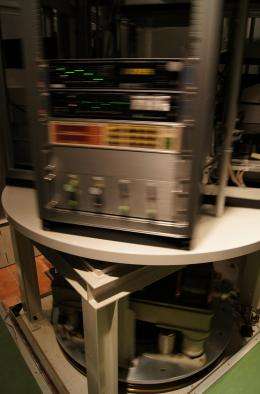Experimental evidence adds to the likelihood of the existence of supersolids, an exotic phase of matter

Supersolids and superfluids rank among the most exotic of quantum mechanical phenomena. Superfluids can flow without any viscosity, and experience no friction as they flow along the walls of a container, because their atoms 'condense' into a highly coherent state of matter. Supersolids are also characterized by coherent effects, but between vacancies in a crystal lattice rather than between the solid’s atoms themselves.
The reduction in the rotational inertia of a bar of solid helium-4 as it was cooled to very low temperatures provided the first experimental evidence for supersolids. Physicists interpreted the reduction to mean that some amount of supersolid helium had formed and decoupled from the remainder of the bar, affecting its rotational inertia and frequency. Others argued that the reduction in inertia resulted from a change in the helium’s viscosity and elasticity with temperature, rather than from the onset of supersolidity.
Kimitoshi Kono from the RIKEN Advanced Science Institute in Wako, Japan, Eunseong Kim from KAIST in Korea, and their colleagues from these institutes have now disproved the alternative interpretation by simultaneously measuring the shear modulus (a measure of viscosity and elasticity) and the rotational inertia of a solid helium-4 cell as its temperature dropped from 1 kelvin to 15 thousandths of a kelvin. The cell was made to rotate clockwise and then counterclockwise periodically, as well as to rotate clockwise or counterclockwise continuously (Fig. 1). The continuous rotation affected the inertial mass of the helium but its shear modulus, allowing these quantities to be monitored independently.
Under continuous rotation, the degree of change in the rotational inertia had a clear dependence on rotation velocity, while the shear modulus did not. In addition, the energy dissipated by the rotation increased at high speeds. Both of these observations contrast to what would be expected if viscoelastic effects were at play, rather than supersolidity. The researchers also found that periodic rotation and continuous rotation affected the rotation differently, raising new questions about the experimental system.
The data support the interpretation that changes in the rotational inertia of helium-4 at low temperature result from supersolidity. This is important because of the novel and surprising nature of the phenomenon itself, says Kono. “Superfluidity in a solid is a very radical concept which, if proven, is certainly a good candidate for the Nobel Prize” he adds. “Therefore the first priority is to determine whether it can be proven in a fashion that will convince the low-temperature physics community.”
More information: Choi, H., et al. Evidence of supersolidity in rotating solid helium. Science 330, 1512–1515 (2010). www.sciencemag.org/content/330/6010/1512.abstract
Provided by RIKEN



















